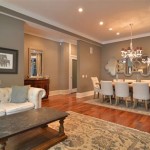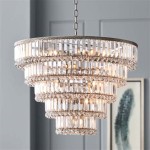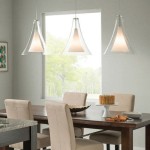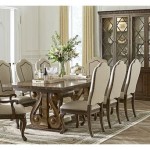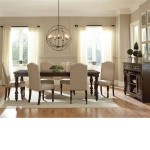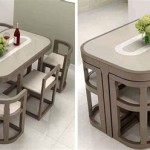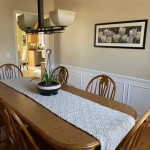Dining Room Paint Color Ideas: Creating the Perfect Ambiance
The dining room serves as a focal point for gathering, sharing meals, and creating memories. Consequently, the selection of dining room paint colors is a crucial decision that significantly impacts the overall atmosphere and experience. The color scheme contributes to setting the mood, influencing appetite, and complementing the room's architectural style and furnishings. Thoughtful consideration of various factors, including lighting, room size, and desired aesthetic, is essential for achieving a harmonious and inviting dining space.
Choosing the right paint color extends beyond personal preference. It requires an understanding of color psychology, the interplay of light and shadow, and the existing elements within the room. This article explores a range of dining room paint color ideas, providing insights into their characteristics, suitability for different styles, and practical tips for successful implementation.
Understanding Color Psychology and Its Impact on Dining
Color psychology posits that colors have the ability to evoke specific emotions and influence behavior. In the context of a dining room, the selected color palette can directly impact appetite, conversation flow, and the overall dining experience. Therefore, it is vital to understand the psychological effects of various hues before making a final decision.
For example, warm colors like red, orange, and yellow are often associated with stimulation and energy. Red, in particular, is known to increase appetite and encourage conversation, making it a popular choice for dining rooms. However, excessive use of red can be overwhelming and lead to feelings of anxiety. Orange is considered a more approachable and cheerful warm color, promoting social interaction and a sense of comfort. Yellow is associated with happiness and optimism, but should be used judiciously, as certain shades can be perceived as jarring or unsettling.
Cool colors, such as blue, green, and purple, tend to create a more calming and relaxing atmosphere. Blue is often linked to tranquility and serenity, potentially suppressing appetite in some individuals. Green is associated with nature and freshness, promoting a sense of balance and well-being. It can be an excellent choice for dining rooms that emphasize natural elements. Purple, depending on its shade, can evoke feelings of luxury and sophistication or, conversely, a sense of mystery and introspection. Lighter shades of purple, like lavender, can create a delicate and calming ambiance.
Neutral colors, including white, gray, beige, and cream, provide a versatile backdrop that allows other elements in the room to take center stage. They are timeless and adaptable to various styles, from traditional to contemporary. Neutral colors can be combined with accent colors to add depth and personality to the dining space. White, in particular, can create a bright and airy feel, but it is crucial to select the right undertone to avoid a sterile or cold appearance. Gray offers a sophisticated and modern aesthetic, while beige and cream provide warmth and comfort.
Exploring Popular Dining Room Color Palettes
The selection of a dining room color palette should take into account the room's size, lighting conditions, and the desired overall aesthetic. Certain color combinations are particularly well-suited for creating specific moods and enhancing the architectural features of the space.
Classic Elegance: This palette typically incorporates neutral colors like cream, beige, and soft gray, often paired with accents of gold, silver, or deep brown. The result is a timeless and sophisticated look that emphasizes refinement and formality. These colors work well with traditional furniture and ornate details. A subtle wallpaper pattern in a damask or floral design can further enhance the classic elegance of the room.
Modern Minimalism: Modern minimalist dining rooms often feature a palette of white, gray, and black, creating a clean and uncluttered aesthetic. These colors are often used in conjunction with sleek furniture, geometric shapes, and minimal ornamentation. Pops of color, such as a vibrant painting or a colorful centerpiece, can be added to create visual interest without disrupting the overall minimalist feel. This palette is well-suited for smaller dining rooms, as it can create an illusion of spaciousness.
Warm and Inviting: For a dining room that feels cozy and welcoming, consider a palette of warm colors like terracotta, rust, olive green, and deep yellow. These colors evoke a sense of comfort and relaxation, making them ideal for creating a space where people feel at ease. Natural materials, such as wood and stone, complement this palette and enhance its warmth. A textured wall finish, such as Venetian plaster, can add depth and character to the room.
Coastal Chic: A coastal-inspired dining room typically features a palette of blues, greens, and whites, reminiscent of the ocean and sky. These colors create a fresh and airy atmosphere, perfect for evoking a sense of relaxation and tranquility. Natural materials, such as rattan, seagrass, and linen, are often used to complement this palette. Shells, driftwood, and other coastal-themed accessories can be incorporated to further enhance the coastal vibe.
Dramatic and Bold: For those who prefer a more dramatic and statement-making dining room, consider using dark and saturated colors like deep navy, emerald green, or burgundy. These colors create a sense of luxury and sophistication, but should be used judiciously, as they can make a room feel smaller. To balance the darkness, incorporate lighter accents, such as white trim, metallic details, and ample lighting. A bold statement piece, such as a large chandelier or a striking piece of artwork, can further enhance the dramatic effect.
Practical Tips for Choosing and Applying Dining Room Paint Colors
Selecting the right paint color is only the first step. Proper application and consideration of practical factors are essential for achieving the desired result. Several key considerations can ensure a successful dining room makeover.
Consider Lighting: Artificial and natural lighting profoundly affect how a paint color appears in a room. Before committing to a color, test it in the room under different lighting conditions throughout the day. North-facing rooms tend to have cooler light, while south-facing rooms receive warmer light. This variance will influence the color's appearance. In spaces with limited natural light, opt for lighter and brighter colors to maximize the available illumination. Conversely, in rooms with ample natural light, darker colors can be used to create a more dramatic effect. Consider the type of light bulbs used, as different bulbs emit different color temperatures, impacting the overall color perception.
Test Paint Samples: Never rely solely on paint swatches or online images to determine the right color. Purchase small samples of several colors and paint them directly onto the walls of the dining room. Observe the colors under different lighting conditions and at different times of the day. Live with the samples for a few days to get a better sense of how they will look in the space. Pay attention to how the colors interact with existing furniture, flooring, and accessories.
Choose the Right Paint Finish: The paint finish affects the durability and appearance of the walls. For dining rooms, a satin or eggshell finish is generally recommended. These finishes are durable, easy to clean, and have a slight sheen that reflects light without being overly glossy. Matte finishes are more forgiving of imperfections but can be more difficult to clean. High-gloss finishes are very durable and easy to clean, but they can be too reflective for dining rooms, highlighting any imperfections in the walls. Consider the level of traffic and potential for spills when selecting the finish.
Consider the Room's Size and Shape: The size and shape of the dining room can influence the perceived effect of different colors. Lighter colors can make a small room feel larger and more open, while darker colors can make a large room feel cozier and more intimate. To visually widen a narrow room, paint the shorter walls a lighter color and the longer walls a darker color. To lower a high ceiling, paint it a darker color than the walls. Use vertical stripes to make a low ceiling appear higher. Horizontal stripes can make a narrow room appear wider.
Complement Existing Furnishings: The paint color should complement the existing furniture, flooring, and accessories in the dining room. Consider the colors and styles of these elements when selecting a paint palette. If the furniture is dark and heavy, opt for lighter wall colors to create balance. If the furniture is light and airy, darker wall colors can provide a grounding effect. Consider the overall style of the room when selecting a palette. A traditional dining room will likely call for a different color scheme than a modern dining room.
Don't Be Afraid to Experiment: While it's important to consider the guidelines and suggestions outlined in this article, don't be afraid to experiment and express personal style. Ultimately, the best dining room paint color is one that reflects individual tastes and creates a space that is both functional and aesthetically pleasing. Consider using an accent wall to add a pop of color or to create a focal point in the room. Use stencils or other decorative techniques to add visual interest to the walls. Consider painting the ceiling a different color than the walls to create a more dramatic effect.
By carefully considering these factors and applying these practical tips, one can confidently select and implement the ideal dining room paint colors, transforming the space into a welcoming and stylish setting for memorable gatherings.

The Best Dining Room Paint Color
:strip_icc()/cdn.cliqueinc.com__cache__posts__209952__if-you-do-this-one-thing-you-dont-need-to-redecorate-your-dining-room-1997706-1480544442.700x0c-7744b38e1e3c4806bd6da128e6d789b6.jpg?strip=all)
The 12 Best Dining Room Paint Colors

55 Dining Room Paint Color Ideas And Inspiration Gallery Images Blue Colors

8 Beautiful Dining Room Paint Ideas Paintzen

Best Paint Colors For Dining Rooms Forbes Home

36 Best Dining Room Paint Colors Color Schemes For Rooms

16 Best Dining Room Paint Colors Color Ideas For

The Best Dining Room Paint Color

12 Dining Room Paint Colors Ideas Inspiration Beamin Moore

36 Best Dining Room Paint Colors Color Schemes For Rooms

